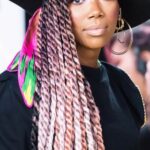
Source: iOne Digital / other
Black hair is everything.
Strong, soft, coiled or curly, Black hair is finally being embraced for its beauty. “The most unique thing about Black hair is the texture and versatility,” says Kiyah Wright, celebrity hair stylist and Gold Series and Royal Oils ambassador. “I love the way that Black hair can curl naturally and can go from Afro to curly to straight.” She’s got a point. Whether styled in a chic relaxed cut, natural and big, texturized lush curls or sleek braids, Black hairstyles aren’t just dynamic, they’re also trendsetting.
Look back at pictures of Black women from the past and the defining styles were always dazzling and comment worthy—that’s likely why they’re often periodically reimagined. From elegantly coiffed Bantu Knots to Ghana Braids, many of our favorite ‘dos are in fact classics. But achieving fabulous hair isn’t just about getting the ’do. “The health of your hair ultimately impacts your styled look. If the hair is unhealthy, it can appear dull, dry, frizzy and be more prone to breakage,” says Dr. Rolanda Wilkerson, Principal Scientist, P&G Beauty. “Unhealthy hair, if not properly addressed can result in breakage and thin looking hair.”
Great hair care rituals are an essential part of grooming, and self-love. That’s why we’ve partnered with Gold Series and Royal Oils Rooted in Science initiative to celebrate our tradition of beautiful, healthy hair. Need some hair inspiration? Take a look at some of the most iconic styles from the past and dig into the greatness that is Black hair history. Learn more about the look and your hair care with these awesome expert tips and products from Royal Oils and Gold Series.
1. The Look: Box Braids
Traced back to Namibia

Source: iOne Digital / other
A protective style when done correctly, box braids add versatility, work on a spectrum of Black hair types, and can be dressed up or down for any outfit, the choice is yours. Box braids can be traced back to Namibia—more than 3000 years ago. Fast forward to present day and this braided style went pop thanks to stars such as Brandy and Janet Jackson. Still the classic is forever evolving. Nowadays, knotless braids are the clear favorite.
2. The Look: Bantu Knots
Traced back to: South Africa

Source: iOne Digital / other
Also known as Zulu or Nubian Knots, the creation of Bantu Knots is credited to the Zulu nation of South Africa. This style is literally one of the Black-est ‘dos you can wear. Why? “Bantu” means people in Zulu. The stunning look has been donned by countless celebs over the last few decades, from Rihanna to Tracee Ellis Ross.
3. The Look: Fulani Braids
Traced back to: West Africa

Source: iOne Digital / other
Like placing beads, cowrie shells or other ornaments in your hair? Thank the Fulani tribe for being among the pioneers of this ornate style. The West African tribe is credited as one of the architects of this jaw-dropping look, which has been adopted by women all over the world, and more specifically the addition of embellishments as staples in the look. Alicia Keys, Teyonah Paris and Solange are just a few women who’ve sported this look.
Rock it With Care: Don’t forget to moisturize. “We’ve found that no matter the choice of style or state the hair is in (relaxed, natural or transitioning), our hair needs moisture. It craves moisture due to its natural texture,” says Dr. Wilkerson. “So, the first thing to do is to prep hair with moisturization. Moisturization can be delivered via different types of products that will protect the hair from damage, and are best used via a regimen system like the Gold Series Hair Repair Collection.”
Pro Tip: “I suggest trying the new Royal Oils Protective Styles Collection to extend the life of your protective style. The lineup includes a Refreshing Root Rinse to remove build up, a Nighttime Scalp Tonic Lotion to reduce scalp dryness and condition the hair, a Hair Freshening Mist to give hair a scent refresh and light conditioning, and a Frizz Tamer to tame frizz and new growth without leaving build up.”
4. The Look: Statement Hair in Tight Braids & Cornrows
Traced back to Ethiopia

Source: iOne Digital / other
For centuries our ancestors have been using hair and adornments to make powerful statements. Elaborate designs were used for everything from showcasing social status to announcing or celebrating battle. To that end, hair wasn’t just fashion, it was a way of life. While the name cornrows was dubbed during relatively recent times—primarily due to their resemblance to the rows utilized to harvest crops in cornfields— tight, intricately woven braids have been worn by Africans for many generations. Beyonce, Yara Shahidi and Ciara are known for sporting enviable statement hair.
5. The Look: Ghana Braids
Traced back to Ghana

Source: iOne Digital / other
Over the last few years, more and more African Americans have been traveling to Ghana—but few may know the country is the source of one of the most popular braided hairstyles of the last three decades. Ghana braids, also known as banana braids and fishbone braids, date back to sculptures from 500 BC. Ghana braids are known for its expanding girth and have been used to achieve an array of looks. Beauties such as KeKe Palmer, Serayah and Regina King have popularized this ‘do.
6. The Look: Straw Curls
Traced Back to Ethiopia

Source: iOne Digital / other
Carefully coifed natural looks are becoming even more popular. B. Simone and Parker McKenna are just two celebs to add to the list of the countless women embracing this ‘do. This look comes straight from the continent of Africa. In many Ethiopian tribes, the men used butter made from herded cattle and used long rods to transform afros into elongated coils and curls. Traditionally known as dayta, the style is often packed with so much butter, the hair is white until it dries.
Rock it With Care: Re-think the frequency of your wash days. “Regular washing [is important], especially when styling products are used frequently” says Dr. Wilkerson. “Styling products along with build up from dirt, scalp oils and fungal growth can cause the scalp and hair to be unhealthy.”
Pro Tip: “For hair prep and maintenance, use a detangler, like the Gold Series Leave-On Detangling Milk, apply a product that protects and polishes the hair while it’s styled, like the Triple Care Braid Cream, and use a hydrating treatment to lock in moisture, like the Hydrating Butter Crème.”
7. The Look: Fades
Traced Back to Benin

Source: iOne Digital / other
Did you know that the warrior women of Benin wore fades and short cuts to show their strength? The military group—also the inspiration behind the Dora Milaje in Black Panther—was legendary for their precision and fierceness. Sanaa Lathan and Tiffany Haddish are just a few celebrities that reminded us that unlike Sampson, we don’t need length to be strong.
8. The Look: Wigs
Traced Back to Egypt

Source: iOne Digital / other
Wigs made their first appearance around 4000 years ago in Egypt before they made their way to Europe. Yea, so the next time someone trolls you and says you hate your African roots because you don the protective style, let them know you’re honoring timeless African traditions. The literal queens of versatility, wigs were used for special occasions in Egypt, and today, not much has changed. So, go ahead and rock that 40-inch hot pink wig. If he thought that was your real hair, that’s on him.
9. The Look: Locs
Traced Back to Egypt

Source: iOne Digital / other
From Africa to the Caribbean, locs have been a longstanding cultural staple. Still, they are most often connected to the Rastafari movement (followers believe the hair aligns the wearer with God, Jah). Today, locs are also a beautiful embodiment of Black culture and a healthy hairstyle that promotes growth and minimal shedding. People even go to braiders to achieve this style using extensions in the form of soft and boho locs.
Rock It With Care: Start at the root, literally. “Caring for your scalp is the key to maintaining healthy hair,” says Dr. Wilkerson. “When the scalp is irritated and not cared for, it impairs the hair fibers that emerge from your scalp, which results in unhealthy hair.”
Pro Tip: “I recommend the Royal Oils Collection from Head & Shoulders because it’s designed to relieve irritation and hydrate from scalp to tip for long-lasting scalp relief and soft, moisturized hair. Incorporating products with a scalp care active, like zinc pyrithione (ZPT), into your routine is important to maintain scalp health and, thus, hair health.”
10. The Look: Afro
Traced Back to the continent

Source: iOne Digital / other
Worn all over the continent, Afros became ultra-trendy in the United States during the 60s through the mid 70s as a statement against resistance to oppression. Later used in political artwork, the Afro then went mainstream, and the symbolism, and the style’s popularity, began to wane. In the 90s, natural hair made a brief comeback. Three decades later, Afros are as common as any other style. Celebs from Solange to Erykah Badu are known for this dynamic look.
Find out more about Royal Oils and The Gold Series product lines.
Interested in learning more about your direct connection to Africa? Trace your family history with Crowns of Heritage and African Ancestry.


